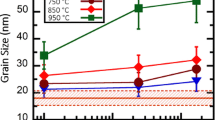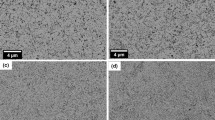Abstract
ZrO2, Y2O3, and rare earth oxides with related structures are attractive candidates for dispersion strengthening of copper alloys but pose significant processing challenges owing to the low solubility of the oxide-forming elements in Cu. It is shown that the problems may be circumvented by a synthesis approach coupling rapid solidification and internal oxidation, followed by standard powder metallurgy consolidation. Cu-Zr and Cu-Y alloys were melt spun into ribbons ∼-50-to 150-Μm thick and internally oxidized at 1023 to 1223 K to yield ∼1 vol pct of ZrO2 or Y2O3 particles ranging in size from 5 nm up to ∼3150 nm. The coarser oxides result from direct oxidation of the intermetallic segregate, whereas the finer ones are generated by a dissolution-reprecipitation process. The relative proportions of fine and coarse oxides and the homogeneity of the distribution are related to segregation scale in the melt-spun ribbon and the relative permeabilities of oxygen and the oxidizable element in the alloy, which depend on the internal oxidation temperature. The oxide dispersoids were mostly cubic zirconia or cubic yttria and exhibited predominantly cube-on-cube orientation relationships with the matrix. Analysis of particle shapes revealed that the dominant interfaces are of the type {001}OX ∥ {001}Cu and {1¯11}OX ∥ {1¯11}Cu and could be explained by image charge interaction concepts. Extrusion produced an elongated grain structure but no significant changes in the oxide distribution.
Similar content being viewed by others
References
A.V. Nadkarni, E. Klar, and W.M. Shafer:Met. Eng. Q., 1976, pp. 10–15.
A.V. Nadkarni: inHigh Conductivity Copper and Aluminum Alloys, E. Ling and P.W. Taubenblat, eds., TMS-AIME, Warrendale, PA, 1984, pp. 77–101.
N.J. Grant, A. Lee, and M. Lou: inHigh Conductivity Copper and Aluminum Alloys, E. Ling and P.W. Taubenblat, eds., TMS-AIME, Warrendale, PA, 1984, pp. 103–17.
J.L. Meijering and M.J. Druyvesteyn:Phil. Res. Rep., 1947, vol. 2, pp. 260–80.
N. Komatsu and N.J. Grant:Trans. TMS-AIME, 1962, vol. 224, pp. 705–13.
J.H. Swisher and E.O. Fuchs:Trans. TMS-AIME, 1969, vol. 245, pp. 1789–94.
J.H. Swisher and E.O. Fuchs:J. Inst. Met., 1970, vol. 98, pp. 129–33.
W. Scheithauer, Jr., R.F. Cheney, and N.E. Kopatz: inModern Developments in Powder Metallurgy, H.H. Hausner, ed., Plenum Press, New York, NY, 1971, vol. 5, pp. 149–58.
H. Schreiner and H. Ohmann: inModern Developments in Powder Metallurgy, H.H. Hausner, ed., Plenum Press, New York, NY, 1971, pp. 125–36.
R.S.W. Shewfelt and L.M. Brown:Phil. Mag., 1974, vol. 30, p. 1135.
J. Rösier and E. Arzt:Acta Metall. Mater., 1990, vol. 38, pp. 671–83.
M.S. Nagorka, C.G. Levi, G.E. Lucas, and S.D. Ridder:Mater. Sci. Eng., 1991, vol. A142, pp. 277–89.
M.S. Nagorka, G.E. Lucas, and C.G. Levi:Metall. Mater. Trans. A, 1995, vol. 26A, pp. 873–81.
F.N. Rhines, W.A. Johnson, and W.A. Anderson:Trans. TMS-AIME, 1942, vol. 147, pp. 205–21.
D. Arias and J.P. Abriata: inBinary Alloy Phase Diagrams, T.B. Massalski, ed., ASM INTERNATIONAL, Metals Park, OH, 1990, p. 1511.
D.J. Chakrabarti and D.E. Laughlin:Bull. Alloy Phase Diagrams, 1981, vol. 2 (3), pp. 315–19.
K.A. Jackson, J.D. Hunt, D.R. Uhlman, and T.P. Seward III:Trans. TMS-AIME, 1966, vol. 236, p. 149.
S.C. Flood and J.D. Hunt:J. Cryst. Growth, 1987, vol. 82, pp. 552–60.
M. Rappaz and Ch.-A. Gandin:Acta Metall. Mater., 1993, vol. 41 (2), pp. 345–60.
R.L. Pastorek and R.A. Rapp:Trans. TMS-AIME, 1969, vol. 245, pp. 1711–20.
H.S. Carslaw and J.C. Jaeger:Conduction of Heat in Solids, 2nd ed., Oxford University Press, Oxford, United Kingdom, 1959, p. 200.
J.H. Swisher: inOxidation in Metals and Alloys, ASM, Metals Park, OH, 1970, pp. 235–67.
V. Lanteri, A.H. Heuer, and T.E. Mitchell: inScience and Technology of Zirconia II, N. Claussen, M. Rühle, and A. Heuer, eds., American Ceramics Society, Columbus, OH, 1984, pp. 118–30.
F. Ernst:MRS Symp. Proc, 1990, vol. 183, pp. 49–54.
F. Ernst, P. Pirouz, and A.H. Heuer:Phil. Mag. A, 1991, vol. 63, pp. 259–77.
H.J. Fecht and H. Gleiter:Acta Metall., 1985, vol. 33, pp. 557–62.
D.M. Williams and G.C. Smith: inOxide Dispersion Strengthening, G.S. Ansell, T.D. Cooper, and F.V. Lenel, eds., Gordon and Breach, New York, NY, 1968, pp. 509–36.
G. Necker and W. Mader:Phil. Mag. Lett., 1988, vol. 58, pp. 205–12.
Y. Gao and K.L. Merkle:J. Mater. Res., 1990, vol. 5, pp. 1995–2003.
T. Muschik: inMetal/Ceramic Interfaces In Internally Oxidized Pd-Al Alloys, Internal Report, Materials Department, University of California, Santa Barbara, CA, 1990.
A.M. Stoneham and P.W. Tasker:J. Phys., 1988, vol. C5, pp. 99–113.
V. Jayaram, M. De Graef, and C.G. Levi:Acta Metall. Mater., 1994, vol. 42 (6), pp. 1829–46.
J.P. A. Löfvander and C.G. Levi: University of California, Santa Barbara, CA, unpublished research, 1993.
Author information
Authors and Affiliations
Additional information
MICHAEL S. NAGORKA, formerly Graduate Research Assistant, High Performance Composites Center, Materials Department, College of Engineering, University of California at Santa Barbara
Rights and permissions
About this article
Cite this article
Nagorka, M.S., Levi, C.G. & Lucas, G.E. Novel oxide-dispersion-strengthened copper alloys from rapidly solidified precursors: Part 1. Microstructural development. Metall Mater Trans A 26, 859–871 (1995). https://doi.org/10.1007/BF02649083
Received:
Issue Date:
DOI: https://doi.org/10.1007/BF02649083




